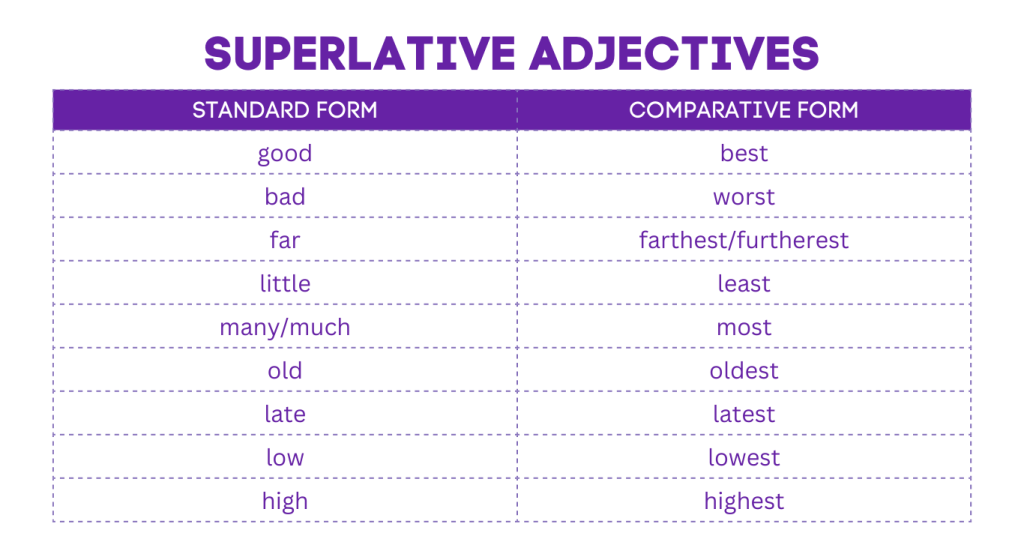Superlative Adjectives – Usage, Tips and Examples
Introduction
Superlative Adjectives
Superlative adjectives play a vital role in expressing the highest degree of a quality when making comparisons. Let’s delve into the realm of superlative adjectives and unravel their significance in the English language.
Analogy of Definition
What are Superlative Adjectives?
Superlative adjectives are used to compare three or more things, highlighting the utmost degree of a particular quality. They are formed by adding -est to the end of the adjective, or by using the word ‘most’ before the adjective.
Method
Rules for Forming Superlative Adjectives
Superlative adjectives are created by adding -est to the end of short adjectives and by using ‘most’ before longer adjectives. Knowing these formation rules is crucial for using superlative adjectives correctly.
One-syllable Adjectives
For one-syllable adjectives, you can typically add the suffix –est to the end of the word without altering the spelling. Following are a few examples
- fine -> finest
- great -> greatest
- fast -> fastest
- strong -> strongest
However for one-syllable adjectves enidng in –e or a consonant-vowel-consonant pattern, hey have spcecific spelling rules.
One-syllable adjectives ending in –e
In case of adjectives ending in –e, you can simply add –st to the end without adding another e.
For example:
- brave -> bravest
- fine -> finest
- large -> largest
- rare -> rarest
One-syllable adjectives ending in consonant-vowel-consonant
When the adjectives with the last three letters following a consonant-vowel-consonant pattern, such as big or thin, you need to double the last consonant and then add –est.
Let’s look at a few examples
- wet -> wettest
- red -> reddest
- sad -> saddest
- hot -> hottest
One- or two-syllable adjectives ending in –y
To form a superlative form of adjectives ending in -y, we need to change the y into an i and then add -est.
For example,
- happy -> happiest
- easy -> easiest
- silly -> silliest
- busy -> busiest
Two-syllable adjectives ending in –er, –ow, or –le
Two-syllable adjectives ending in -er, -ow, or -le form their superlative differently from other long adjectives. For adjectives ending in –er or –ow, simply add –est to the end without altering the spelling. The adjectives ending in –le only require –st, without the need for an additional e.
For example,
- humble -> humblest
- gentle -> gentlest
- tender -> tenderest
- clever -> cleverest
Using Most in Superlative Adjectives
The determination to use suffix -est or the adverb most can be tricky. Uusllay, for short adjectives, we use the suffix -est, while for longer ones we use most. We can simply remeber that we use most for all adjectives with three or more syllables, and for adjectives with two syllables except those that end in –er, –ow, –le, or –y. If the two syllables adjectives have the mentioned ending, we need to remember the rules mentioned above.
Understanding Comparative and Superlative Adjectives
Comparative adjectives are employed to compare two things, while superlative adjectives are utilized to compare three or more things. The distinction lies in the degree of comparison, with superlative adjectives indicating the highest degree of a quality. Let’s understand the concept with an example ,
“Among the students in the class, Sarah is smarter than Jack, but the smartest student overall is Emily.”
In the sentence “Sarah is smarter than Jack, but the smartest student overall is Emily,” “smarter” is the comparative adjective, comparing Sarah’s intelligence to Jack’s. “Smartest” is the superlative adjective, indicating that Emily has the highest level of intelligence among all the students.
Examples
Example 1: The tallest building in the city.
Example 2: She is the most intelligent student in the class.
Example 3: It was the most delicious meal I’ve ever had.

The examples illustrate the use of superlative adjectives to convey the highest degree of a quality in various contexts. Whether describing the tallest building, the most intelligent student, or the most delicious meal, superlative adjectives enhance the clarity and impact of the language used.
Quiz
Tips and Tricks
1. Practice Makes Perfect:
Tip: Engage in exercises and activities that involve using superlative adjectives to reinforce understanding and application.
2. Comparative vs. Superlative:
Tip: Differentiate between comparative and superlative adjectives to accurately convey the degree of comparison in different contexts.
3. Contextual Application:
Tip: Apply superlative adjectives in sentences that highlight the highest degree of a quality to enhance descriptive language.
4. Reading Comprehension:
Tip: Read literature and texts that contain superlative adjectives to recognize their usage and impact in written communication.
5. Creative Writing:
Tip: Engage in creative writing exercises that incorporate the use of superlative adjectives to express vivid and compelling descriptions.
Real life application
Real-Life Applications of Superlative Adjectives:,
Scenario: The Tallest Tower Challenge
In a city planning competition, architects were tasked with designing the tallest tower that would redefine the skyline and symbolize innovation and progress.
Scenario: The Most Beautiful Garden Contest
Horticultural enthusiasts participated in a competition to showcase the most beautiful garden, incorporating vibrant flora and captivating landscapes to captivate the judges and spectators.
Scenario: The Most Delicious Dish Competition
Culinary artists competed to create the most delicious dish that would tantalize the taste buds and earn accolades for its exceptional flavor and presentation.
FAQ's
Like? Share it with your friends






